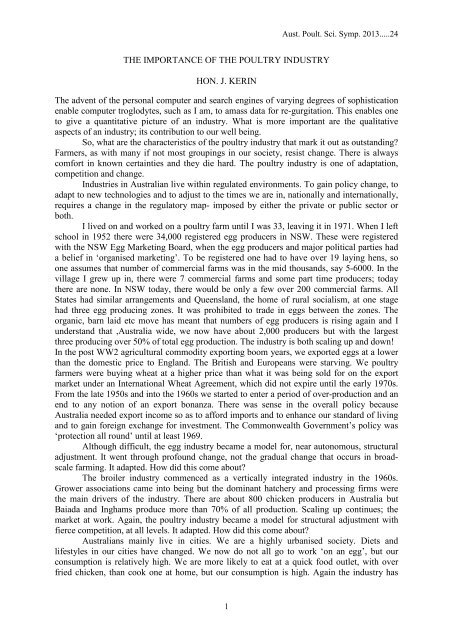APSS 2013 Proceedings - The University of Sydney
APSS 2013 Proceedings - The University of Sydney
APSS 2013 Proceedings - The University of Sydney
Create successful ePaper yourself
Turn your PDF publications into a flip-book with our unique Google optimized e-Paper software.
Aust. Poult. Sci. Symp. <strong>2013</strong>.....24<br />
THE IMPORTANCE OF THE POULTRY INDUSTRY<br />
HON. J. KERIN<br />
<strong>The</strong> advent <strong>of</strong> the personal computer and search engines <strong>of</strong> varying degrees <strong>of</strong> sophistication<br />
enable computer troglodytes, such as I am, to amass data for re-gurgitation. This enables one<br />
to give a quantitative picture <strong>of</strong> an industry. What is more important are the qualitative<br />
aspects <strong>of</strong> an industry; its contribution to our well being.<br />
So, what are the characteristics <strong>of</strong> the poultry industry that mark it out as outstanding?<br />
Farmers, as with many if not most groupings in our society, resist change. <strong>The</strong>re is always<br />
comfort in known certainties and they die hard. <strong>The</strong> poultry industry is one <strong>of</strong> adaptation,<br />
competition and change.<br />
Industries in Australian live within regulated environments. To gain policy change, to<br />
adapt to new technologies and to adjust to the times we are in, nationally and internationally,<br />
requires a change in the regulatory map- imposed by either the private or public sector or<br />
both.<br />
I lived on and worked on a poultry farm until I was 33, leaving it in 1971. When I left<br />
school in 1952 there were 34,000 registered egg producers in NSW. <strong>The</strong>se were registered<br />
with the NSW Egg Marketing Board, when the egg producers and major political parties had<br />
a belief in ‘organised marketing’. To be registered one had to have over 19 laying hens, so<br />
one assumes that number <strong>of</strong> commercial farms was in the mid thousands, say 5-6000. In the<br />
village I grew up in, there were 7 commercial farms and some part time producers; today<br />
there are none. In NSW today, there would be only a few over 200 commercial farms. All<br />
States had similar arrangements and Queensland, the home <strong>of</strong> rural socialism, at one stage<br />
had three egg producing zones. It was prohibited to trade in eggs between the zones. <strong>The</strong><br />
organic, barn laid etc move has meant that numbers <strong>of</strong> egg producers is rising again and I<br />
understand that ,Australia wide, we now have about 2,000 producers but with the largest<br />
three producing over 50% <strong>of</strong> total egg production. <strong>The</strong> industry is both scaling up and down!<br />
In the post WW2 agricultural commodity exporting boom years, we exported eggs at a lower<br />
than the domestic price to England. <strong>The</strong> British and Europeans were starving. We poultry<br />
farmers were buying wheat at a higher price than what it was being sold for on the export<br />
market under an International Wheat Agreement, which did not expire until the early 1970s.<br />
From the late 1950s and into the 1960s we started to enter a period <strong>of</strong> over-production and an<br />
end to any notion <strong>of</strong> an export bonanza. <strong>The</strong>re was sense in the overall policy because<br />
Australia needed export income so as to afford imports and to enhance our standard <strong>of</strong> living<br />
and to gain foreign exchange for investment. <strong>The</strong> Commonwealth Government’s policy was<br />
‘protection all round’ until at least 1969.<br />
Although difficult, the egg industry became a model for, near autonomous, structural<br />
adjustment. It went through pr<strong>of</strong>ound change, not the gradual change that occurs in broadscale<br />
farming. It adapted. How did this come about?<br />
<strong>The</strong> broiler industry commenced as a vertically integrated industry in the 1960s.<br />
Grower associations came into being but the dominant hatchery and processing firms were<br />
the main drivers <strong>of</strong> the industry. <strong>The</strong>re are about 800 chicken producers in Australia but<br />
Baiada and Inghams produce more than 70% <strong>of</strong> all production. Scaling up continues; the<br />
market at work. Again, the poultry industry became a model for structural adjustment with<br />
fierce competition, at all levels. It adapted. How did this come about?<br />
Australians mainly live in cities. We are a highly urbanised society. Diets and<br />
lifestyles in our cities have changed. We now do not all go to work ‘on an egg’, but our<br />
consumption is relatively high. We are more likely to eat at a quick food outlet, with over<br />
fried chicken, than cook one at home, but our consumption is high. Again the industry has<br />
1
















